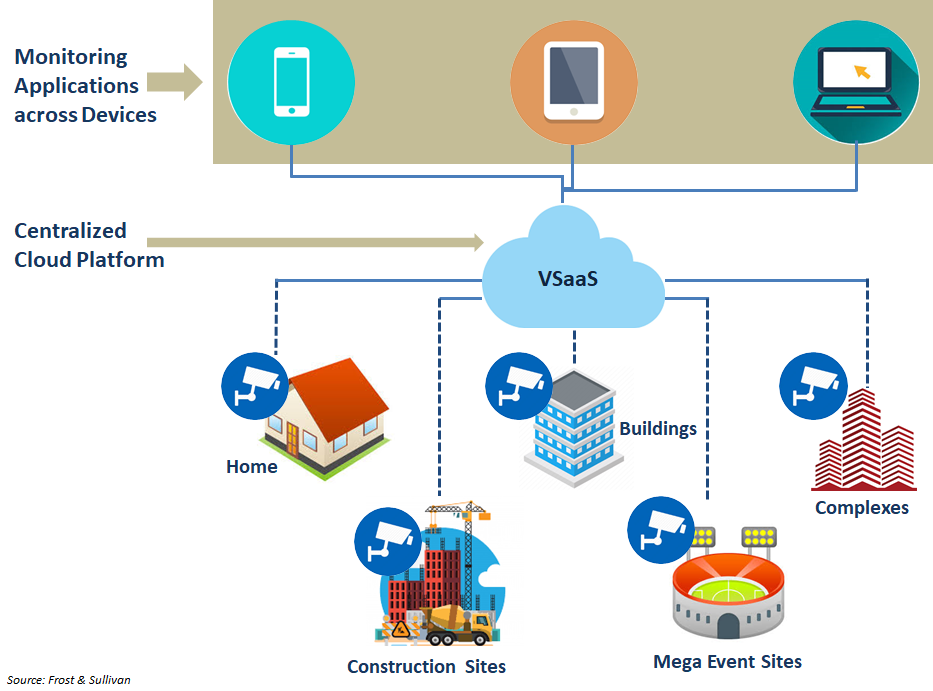2019 saw the launch of commercial 5G networks around the world. Following the initial wave of 5G deployments, major telecom operators across the globe have adopted 5G centric strategies to pace up their network rollouts and tackle the flaring up competition in the segment. Unlike the previous generations, 5G has a massive potential beyond the traditional voice and data services for consumers and is expected to propel a range of industrial uses cases through its enhanced bandwidth and ability to support mission-critical applications. With the potential to seamlessly connect a massive number of devices and handle huge volumes of data in near real-time, 5G networks will provide a platform for the growth of IoT and AI for use cases such as smart cities, remote surveillance, connected vehicles, virtual campus networks, etc. One such fast growing application in the physical security sector is 5G CCTV cameras with AI capabilities.
Amid the rising concern for public safety and security, governments around the world at a federal and local level are pushing for better surveillance in a bid to make their towns, cities, and suburbs safer. As a result, the demand for video surveillance through CCTV cameras has accelerated over the years. With advancements in technology and exponential growth in the connected ecosystem, video surveillance systems have predominantly moved to IP-based network. This has resulted in a massive growth in video data traffic, and in turn created the need for advanced network infrastructure, which can handle such monumental volume of transmission feeds from different sources. Video surveillance networks are initially deployed through wired infrastructure, predominantly over fiber-optic cables due to the requirement of higher bandwidth. However, fiber network installation requires high capital investment and has a coverage limitation especially in remote locations. On the other hand, mobile wireless connectivity (particularly 4G LTE), is a superior alternative due to its extensive coverage, flexibility, and ease of deployment while installing video surveillance systems at a larger scale. However, as more cameras and recorders are increasingly getting connected to the internet and adoption of higher definition CCTV cameras continue to raise, 4G LTE networks are getting more congested and overburdened.
The ongoing proliferation of 5G networks is helping to overcome these challenges as well as bringing in new opportunities for the development of video surveillance market. 5G network undoubtedly provides a more reliable, higher bandwidth, and low latency connectivity for remote video surveillance solutions as compared to its predecessor wireless networks as well as fiber-based network.
5G based CCTV integrated with AI capabilities:
5G based CCTV cameras are wireless IP cameras capable of transmitting pictures, video and even audio signals over a 5G network. These cameras when integrated with artificial intelligence capabilities are helping in improving the efficacy of video surveillance systems, ushering a new era in the physical security sector.
Initially, video surveillance systems used to be passive where CCTV cameras were mainly used to stream live videos and enterprises used to refer to the stored video feeds only after the security breach had already occurred. No major efforts were made to analyze these vast video footage for detecting a potential security incident beforehand.
5G CCTV cameras leveraging artificial intelligence based solutions like face recognition, object recognition, event recognition, intelligent image processing, remote asset management, behavioral detection, and analytics are leading to the transformation of video surveillance into an active threat detection system. Along with AI, machine learning and deep learning algorithm can also be leveraged to develop advanced video analytics solutions and further improve the intelligence of video surveillance systems. The video analytics solutions are capable of detecting objects or events of interest by analyzing and monitoring live video streams or recorded images from the surveillance cameras. Key advantages and potential use cases of 5G CCTV with artificial intelligence based video surveillance system include:
- High reliability:
Low latency 5G network provides seamless streaming of live video footage to users and further helps in generating a near real-time response in case of emergencies leveraging artificial intelligence. While the continuous availability of video surveillance systems is of critical importance, 5G also guarantees uninterrupted delivery of network services.
- High scalability:
5G network supporting massive machine type communication is driving the development of robust video surveillance systems by configuring a large number of CCTV cameras across applications.
- Higher resolution video:
5G network is capable of transmitting enhanced quality live surveillance videos with the network now supports ultra-HD 4K and even 8K live video transmission.
- Remote coverage:
5G network is capable of connecting remote areas which are not covered under fixed broadband or WiFi connectivity.
- More efficient than humans:
The possibility of security personnel monitoring video footage missing unusual activities is higher. While AI capabilities embedded in 5G CCTV functions at a high level of efficiency and can be configured to detect incidents or actions that do not follow the usual pattern.
- Image processing:
The issue of low quality of image and video clips captured by surveillance cameras can hamper the delivery of accurate analysis. AI can be used to address this issue and help sharpen low-quality images and derive meaningful data.
AI enabled 5G CCTV driving video surveillance-as-a-service:
Higher bandwidth 5G networks provide ultra-fast transmission speeds, enabling users to quickly upload the video surveillance footage from different sources into a centralized cloud platform rather than storing it in local systems. These video footages can be later accessed easily on-demand by users from remote locations. This led to the emergence of video surveillance-as-a-service (VSaaS); an advanced cloud based video management service capable of viewing, playback, and monitoring of surveillance footage and also enabling near real-time analysis using artificial intelligence.
Multi-Access Edge Computing (MEC) improving the effectiveness of VSaaS:
Amid rising security concerns regarding the transfer of sensitive video surveillance data to the cloud, MEC is enabling the processing of video data within the edge of AI enabled 5G CCTV network. Instead of sending all video surveillance data to the cloud, MEC reduces security risk by processing the data locally and transferring filtered data to the cloud. This approach helps enterprises to significantly lower cloud storage cost and improve bandwidth utilization efficiency. Moreover, MEC also improves the responsiveness of video surveillance systems by reducing the latency involved in transmitting or receiving data to or from cloud-based backend servers.
Use cases and opportunity for industries:
- Automating access control, intrusion detection, motion detection, and behavior detection to improve security across smart premises (airports, hospitals, educational institutes, manufacturing facilities, etc.):
5G CCTV fueled by AI techniques like face recognition can be used to provide automated access to individuals inside a premise or else generate an alarm based on their authorization level. Moreover, it can also help understand people’s actions, skin color, voice, emotions, clothing, and more.
Implementing this solution in industries like manufacturing, construction, etc. can help determine anomalies regarding worker safety without human intervention. For example, workers not complying with standard safety procedures like wearing helmets, gloves or yellow jackets can be identified automatically, minimizing worker safety risks in manufacturing facilities and construction sites.
AI powered 5G CCTV leveraging behavioral analytics can be implemented in facilities with high footfall or popular tourist spots. It can determine human behavior from live video feeds and match it with predefined suspicious behavior data to identify offenders in real-time. This can drastically reduce the requirement of deploying a large number of physical security personals in these areas.
- Improving transportation monitoring system through traffic detection, incidence detection, and pedestrian monitoring:
AI enabled 5G CCTVs leveraging video analytics can be implemented for improving the traffic flow in real-time by detecting various traffic conditions. This traffic monitoring data can be used to improve the efficiency of traffic management system by dynamically adjusting the green period of each traffic signal. Besides, it can be used to automate number plate recognition, detect illegal parking, abnormal speeding, road accidents or vehicle breakdown and send alarms to concerned authorities like fire or ambulance service. It can also detect pedestrian density and help set average speeds for vehicles to enhance road safety measures.
- Enabling healthcare monitoring and surgical video analysis:
One of the potential use-cases of AI powered CCTV cameras can be healthcare monitoring which will enable remote detection of patients’ health conditions like respiratory rate. Moreover, AI powered CCTVs can also leverage computer vision for analyzing surgical videos in real-time and predict or suggest the next step while cross-referring a library of surgical guides.
- Enhancing customer shopping experience in the retail sector:
Video analytics can enable retailers to identify hot zones in their shopping facility where maximum people stop or spend time through motion detection. It can also help identify the busiest period in a store and accordingly develop strategies for staff or resource management. Moreover, it can provide information about customer satisfaction to retailers by analyzing facial expressions of customers entering or walking out of stores.
- Driving remote asset management:
Ideal machine parameters and conditions can be fed into an AI powered video analytics system to analyze performance and behavior patterns of machines. This data can be used to identify assets that need maintenance or not being utilized optimally through AI enabled CCTV cameras in real-time. Additionally, through predictive analytics users can be notified with alerts when to expect machine failure, and help reduce the machine downtime.
Opportunity for regional telcos:
5G network went live in the Middle East in 2018 with Ooredoo Qatar claiming to have launched the world’s first commercial 5G network in May. Several GCC countries particularly UAE, Kuwait, Bahrain, and Saudi Arabia followed the suit by commercializing 5G network during 2019. Meanwhile, Egypt and Lebanon are finalizing their 5G strategy and expected to commercially launch the service in 2020.
Currently, majority of the regional telcos are engaged in expanding coverage or commercializing 5G network with a focus mainly towards the consumer segment. However, massive opportunity for the 5G network is generated in the B2B space amid ongoing development of several real-life use cases for enterprises. Telcos now need to be more directed towards these emerging use cases and develop a 5G-centric service portfolio for enterprise. Telecom operators can facilitate the implementation of AI enabled 5G CCTV solution by offering dedicated 5G connectivity, ensuring enhanced and uninterrupted remote video surveillance service.
STC Kuwait became the first operator in the region to launch a 5G connectivity service exclusively for enterprise. Key solutions provided by the operator include Dedicated Data Access, Dedicated Internet Access, and on-demand services such as CCTV and Cloud PBX.
Global leaders like Microsoft Azure, AWS, and IBM cloud continues to dominate the Middle East cloud based AI services segments across verticals. Cloud based AI services in the video surveillance sector mainly include infrastructure (hardware, data centers, etc.), AI basic capabilities (computing power, algorithm, etc.), and advanced AI capabilities (face recognition, behavior detection, etc). Regional operators should now focus on investing in the development of in-house AI capabilities on the back of their gained expertise in implementing AI for optimizing and automating telecom networks.
Conclusion:
Security surveillance systems need the highest level of availability, reliability, and speed. As a result, the high bandwidth and ultra-low latency 5G network is becoming the key enabler of IP camera based remote video surveillance systems. Moreover, increasing adoption of cloud computing, MEC, and AI is gradually transforming video surveillance systems into a robust, smarter, and more intelligent security solution. While cloud computing and MEC are facilitating video surveillance-as-a-service (VSaaS), AI is unlocking a wide range of potential use cases across several end-use industries. Tapping these emerging opportunities, regional telcos have started adopting an enterprise centric approach for expanding their 5G services portfolio.














